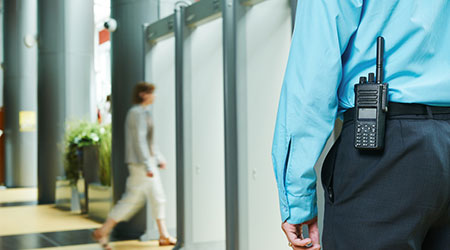Healthcare facilities have a clear directive: heal and provide comfort to patients. Even though the directive is straightforward, there are many elements that go into making it a reality. A significant challenge healthcare facilities face is how to ensure security while maintaining focus on the primary goal.
The standards are high. In today’s world, customers expect to be catered to. That same attitude has been adopted by hospital patients (some refer to them as clients or customers) and those around them (family, friends, etc.). This attitude has caused healthcare facilities to put a greater emphasis on comfort than they have in the past.
Practical reasons for the focus on comfort exist as well. Research shows that the more comfortable patients are in an environment, the faster they’ll heal. Secondly, HCAHPS, which helps determine the amount of government reimbursement for a healthcare facility, focuses on patient experience as one of its primary metrics.
Patient experience, as well as those of family, friends, and staff also requires healthcare facilities to be secure. “Hospitals have not been built with security in mind,” said David Cornelius, Director of Safety and Security for the Frederick Health/Frederick Health Hospital (located in Frederick, Md.) which includes a hospital as well as numerous ambulatory facilities. “Hospitals are focused primarily on creating an open patient experience.”
Besides the security challenges of the physical layout, many hospitals these days have no specific visiting hours but instead welcome visitors all day and night. This is done because it’s been shown patients get better quicker if family and loved ones are there to support and advocate for them.
This challenge is made more difficult by the melting pot that is a hospital. There can be a patient who is dealing with a gunshot in the emergency room while a child lays ill in the pediatric intensive care unit. In addition, when people come into a healthcare facility, they are typically at a low point. Maintaining a facility that is secure like Fort Knox yet still comforting seems to be dual purposes that are at odds with each other.
“It’s not something we thought about in the past,” said Dolly Sullivan, Director of Service Excellence at Frederick Health/Frederick Health Hospital. “We can do better when building facilities in the future, yet it’s a question of how we utilize our resources.”
One way the Frederick Health/Frederick Health Hospital is adjusting is by changing from an open hospital to a visitor management system. Visitors will need to present ID and a reason for visiting the hospital to gain entrance. “We brought this idea to the staff and other councils, and people overwhelmingly approved it and were happy to hear of the move,” said Michael McLane, Vice President Support Services for the Frederick Health/Frederick Health Hospital.
One key to maintaining a secure location is to employ security personnel. A challenge for healthcare facilities is how to utilize security personnel without intruding on the comfort of customers.
At Frederick Health/Frederick Health Hospital, security personnel have a customer service mentality. “The security staff is trained on how to talk to and relate to the public,” said Cornelius. McLane said the security personnel, who are not armed, also “serve as ambassadors to promote the facility.”
Hospitals also are turning to technology. Video cameras can detect aggression based on various metrics. Other cameras can detect if a gun was shot in the vicinity and identify where. Other technology includes can detect the amount of metal a person has on them and where it is on their body.
“You don’t necessarily want people to see the technology, but it’s good to have available when needed,” McLane said.
Sullivan said that it’s important not to overly rely on technology and automated systems: “When people are calling about healthcare, they want to talk to a real person who can provide comfort. Real people also make the difference in terms of safety.”
Despite the best of intentions, it can be challenging for healthcare personnel to determine how best to achieve this balance. At Frederick Health/Frederick Health Hospital, they created a patient and family advisory council, which is made up of former patients and family members who volunteer to serve.
“We ask them to comment on our safety and comfort and how we are doing,” said Jamie White, Vice President of Quality/Patient Experience at Frederick Health/Frederick Health Hospital. “They are very helpful and provide great insight.”
There’s no one size fits all when it comes to marrying comfort and security in healthcare facilities. Each facility has to consider its community, the overall environment, and the team at the facility to determine how to deliver the best care in a safe manner.
While healthcare facilities have a clear directive, completing it is far from simple. The dual responsibilities of keeping patients, visitors, and staff secure and comfortable requires great thought and effort. These goals however, ultimately feed off of each other. “It’s much easier to feel comfort when you feel secure,” said White. It also leads to healing. And that is the mission.

 UF Health Hospitals Rely on Green Globes to Realize Their Full Potential
UF Health Hospitals Rely on Green Globes to Realize Their Full Potential How Healthcare Facilities Can Be Truly Disaster-Resilient
How Healthcare Facilities Can Be Truly Disaster-Resilient TriasMD Breaks Ground on DISC Surgery Center for San Fernando Valley
TriasMD Breaks Ground on DISC Surgery Center for San Fernando Valley Bigfork Valley Hospital Falls Victim to Data Breach
Bigfork Valley Hospital Falls Victim to Data Breach AI-Driven Facilities: Strategic Planning and Cost Management
AI-Driven Facilities: Strategic Planning and Cost Management